



This is a little bit of a departure from the usual guns I review; namely because the sportsman is expensive. 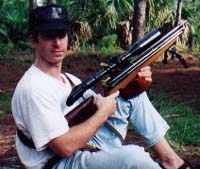 I bought it mostly because I was getting sick of the lame excuses for airguns on the market. Let's be real: if you can hit the target easier by throwing a baseball at it than using the airgun then I don't consider the rifle worth the time or the money. (Pistols are another matter all together.)
I bought it mostly because I was getting sick of the lame excuses for airguns on the market. Let's be real: if you can hit the target easier by throwing a baseball at it than using the airgun then I don't consider the rifle worth the time or the money. (Pistols are another matter all together.)
Let me start off by saying I like it. The price is around $600 for a walnut stock version. It also comes in beech I think. I bought the .22 cal.-- .25 is an option. The specs are as follows: pump pneumatic, one pump easy plinking, two pumps do-able all day for 12 fp for field target, up to five tough pumps for 20 fp for hunting, excellent though not match 16-20 oz adjustable trigger, no sights-need scope, NO recoil, 9 lbs heavy, rubber butt pad, high cheek comb, checkered grips, nice touches like brass trigger and barrel straps.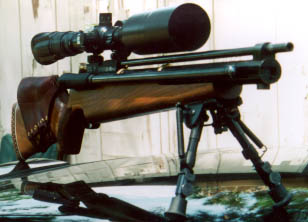
The best part about this gun is the fact that it has adjustable power levels by the number of pumps, it is recoilless, and you don't need a scuba tank/adaptor with the added cost and hassel. No more wondering,"are my shots off or am I running out of CO2?/air?" or try to go on an airplane with a tank. The sound from the barrel with a one pump shot is almost silent. The sound from a two pump shot is enough to let the neighbors know what you are up to in the backyard. But first I would like to tell my story of woe and poor quality control.
When I first received the gun through the mail, UPS, who I dislike, had damaged the stock. No biggy. It is for shooting not looking. Next I noticed my test groups were not consistant. I tried different pellets. No change. I loaded a pellet in the breech and backed it out with a rod. The pellet was OK. Next I test fired into a water tank and examined the pellet. Sure enough the pellet was deformed on one side. Something was hitting the pellet on the way out of the barrel...the moderator or silencer I guessed. It was put on by the factory and misaligned or knocked out of alignment so that it brushed the pellet. With much grunting and destruction of the sound moderator it came off as did the blueing of the barrel tip. Airguns of Arizona, from whom I bought the gun, told me they had heard of this before and offered me a free replacement moderator. I think I'll leave this bad idea off.(Unfortunately the moderator is on in the above photo). I also want to mention the inside of the moderator was full of metal shavings and other particulate matter.
I put a Simmons 6-18x40 airgun scope on the gun and I obtain 3/8" to 1/2" c-t-c groups off a bench at 20 yards. At 50 yards the groups can be 1". These have improved with the addition of a more powerful scope. The recoilless nature allows a variety of less expensive scopes that don't have to withstand a double recoil and thus is a cost savings. A big scope's eye piece though does get in the way of the cocking lever a bit.
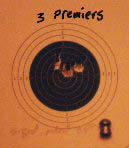
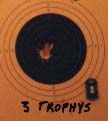 I have tried a whole host of pellets and suprisingly crosman premiers beat silver aces, kodiak matches, silver bears, and lasers. I found improved grouping with oiling and sizing of the pellets so that the hole the premiers punch through the paper touch each other at 23 measured yards off a bench rest.The first bullseye is with crosman premiers and the second is with Beeman Trophys both at about 25 yards. The trophy's are the pellet of choice for this gun!I plan to use the Sportsman in field target competition because I think it is that accurate. The pumping is a bit of a draw-back when competing against pre-charged guns, but it was not a problem in the last match. A little more about the pumping effort. The first is easy and equal to that of many spring piston rifles.
The second pump is only hard at the end of the stroke and about as tough as crushing a aluminum soda can end to end.(that's the best I could come up with) Strokes 3-5 are harder but just require more time. That's really what it is, more time than effort.
I have tried a whole host of pellets and suprisingly crosman premiers beat silver aces, kodiak matches, silver bears, and lasers. I found improved grouping with oiling and sizing of the pellets so that the hole the premiers punch through the paper touch each other at 23 measured yards off a bench rest.The first bullseye is with crosman premiers and the second is with Beeman Trophys both at about 25 yards. The trophy's are the pellet of choice for this gun!I plan to use the Sportsman in field target competition because I think it is that accurate. The pumping is a bit of a draw-back when competing against pre-charged guns, but it was not a problem in the last match. A little more about the pumping effort. The first is easy and equal to that of many spring piston rifles.
The second pump is only hard at the end of the stroke and about as tough as crushing a aluminum soda can end to end.(that's the best I could come up with) Strokes 3-5 are harder but just require more time. That's really what it is, more time than effort.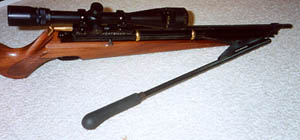
Some of the real positives are the padding on the pump lever, and the brass rings on the compression tube. The stock cheek piece is quite high, and the butt pad is high quality. The stock comes in L or R handed versions, which is important since the trigger hand grip has a nice place for you thumb to rest in a groove. A leftie would have a hard time using a R stock. It really is a massive gun and the center of gravity (or balance) is about three inches forward of the trigger guard. This is a touch too far forward ideally for field target, but acceptable. The trigger though not match seems much ligter than it 16 oz, which is the book spec. it is so light that it is hard to measure on a gauge. The key point is that it is predictable, and light enough to let off and not disturb the recoilless nature of the gun.
The combination of beauty, mass, no recoil, light trigger, and power really make this a balanced combination for an all around airgun. If you like pneumatics so you can see the target fall through the scope, but want to avoid the scuba tanks, this gun is a great buy--assuming you are willing to deal with the quality contol headaches you may encounter.

Alright, this baby is a classic. everyone knows that. It is also an old design so I would not expect it to preform like a truely modern air rifle. These expectations were fullfilled when I tested the Silver Streak. It is a pneumatic and pretty tough to pump, but still within reason.The pump lever is long which gives the needed leverage. The gun is brass and walnut and thus hefty. It looks great.
What really upset me was the trigger. It was heavy and the trigger blade was sharp and, yes painful to the tirgger finger. So, I went to work. After taping the trigger guard I filed the trigger blade round and smooth (since it was square and sharp to start). This made a big difference. I then took apart the trigger mechanism (which is very easy) and placed some grease, not oil, on the two trigger sears. This improved the release by making it much easier and lighter. Some people polish the contact points. The trigger now has a predictable travel for a short distance and then is a little heavier at the release point. Still not great but better and predictable. I also replaced the travel spring with a lighter one. The let-off weight is now 6 pounds. I really think these impovements make the worst part of the gun bareable.
The iron sites provided are not bad. To use the gun at distance I put on a scope. Boy! did this make a difference!Now no can is safe at 66 feet. From Sheridan I ordered the intermount and the long relief 1.5x scope. You need the intermount to mount any scope and only a "long relief" type scope will work. I know, I tried standard scopes, and they wouldn't work; plus, the scope has to be forward to clear the loading breech and the action of the bolt. I found out I like the scope on this gun because it raises up the sight plane so you don't have to bend you head down and forward to aim. In standing/off hand shooting very upright is the best posture and the scope gives you this.
The plating and stock,and butt plate are beautiful, and the gun is much quieter than the sheridan type E CO2 pistol. It has a good weight of 6 lbs. and a length of 36 1/2". Velocity is supposedly 675 fps. and accuracy by me is 1/2" groups at 10 meters and one inch at 20 meters.
I have seen a peep sight available that mounts to screw holes near the bolt, though there seems to be no front blade adaptor to go with it.I guess you are just supposed to sight off the blade. It is a very small arrangement. The Streak is .20 cal of course. For the money ,under $150, it's a good deal for a gun that will last. I have heard that the new Sheridans will have adjustable triggers in the future. Sign me up. An excellent review of trigger tweaking is at Ian Pellant's page. (see links)
and don't forget the guestbook .